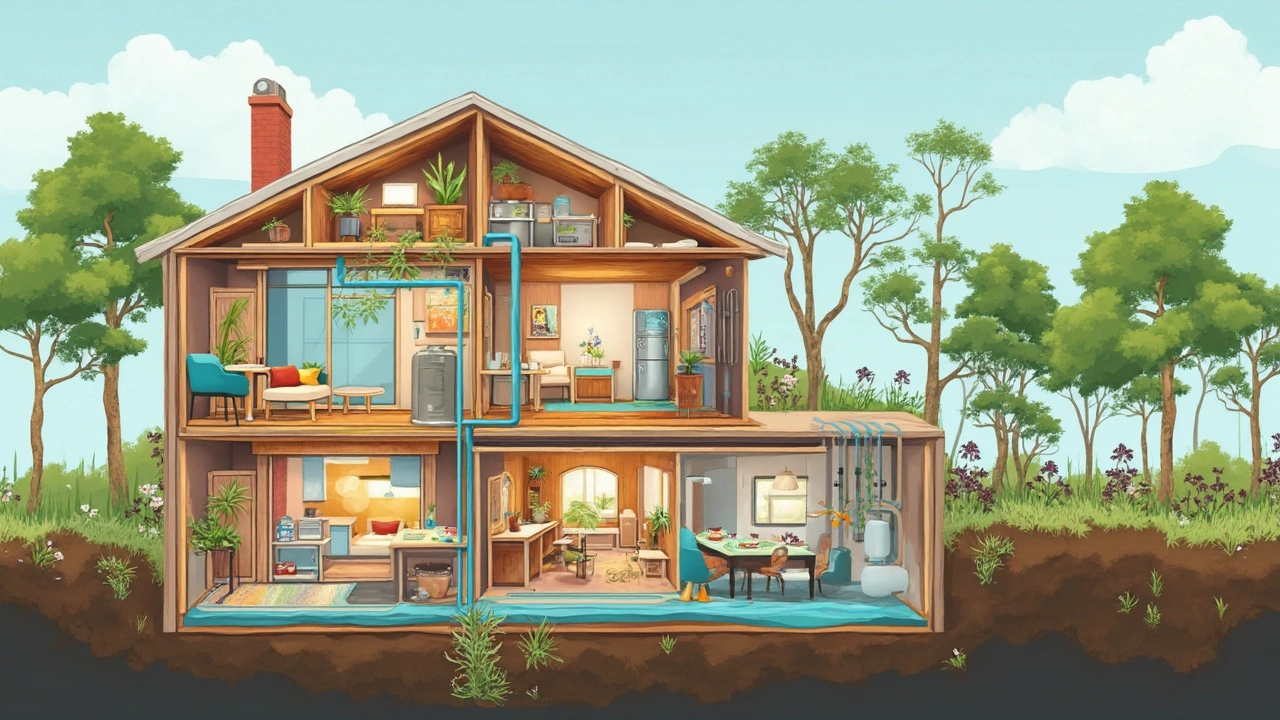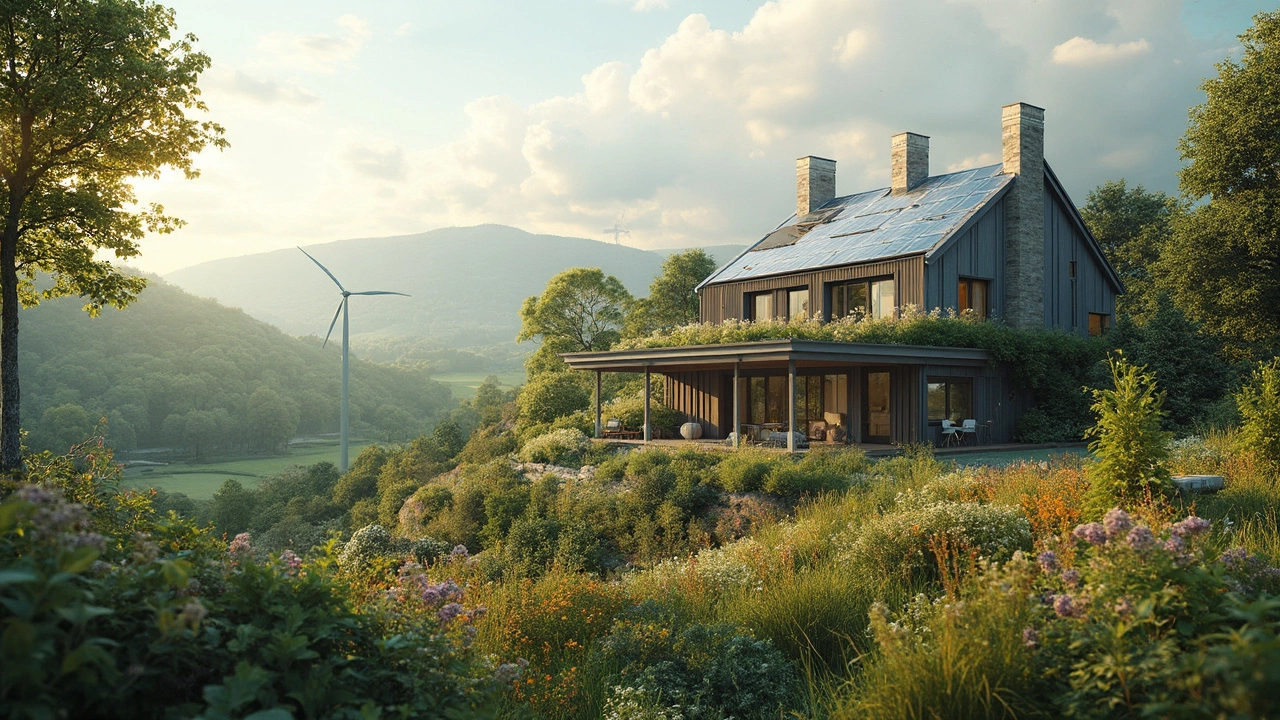Thinking about building a fully sustainable house? It's a noble and exciting adventure! But let's cut to the chase—how much does it really cost? From the right materials to energy solutions, creating an eco-friendly home involves many factors.
First off, understand that sustainable houses aren't just about using green materials. It's about energy efficiency, harmony with nature, and sometimes, embracing smart technology. Each choice you make can influence the overall price tag, so it's crucial to balance your eco-goals with your budget.
Now, let's talk prices. Expect a few surprises—both good and bad. Think about the long-term savings from lower energy bills, but also the initial costs of installation. Whether you're just starting out or refining your plans, knowing what's ahead can help avoid those unexpected 'gotcha' moments.
- Understanding Sustainable Houses
- Key Materials and Resources
- Renewable Energy Options
- Challenges and Solutions
- Cost Breakdown
Understanding Sustainable Houses
So, what exactly is a sustainable house? It's more than just a buzzword. It's a home designed to have the smallest environmental impact possible, reducing energy consumption, and conserving natural resources. Think of it as living more harmoniously with nature.
One crucial part of this concept is energy efficiency. Sustainable homes often use passive solar design, meaning they capture the sun's energy to keep the house cozy in winter and cool in summer. This can cut down heating and cooling costs by up to 90%! Impressive, right?
Building materials matter too. From reclaimed wood to recycled steel, every choice matters. These materials not only last longer but often require less energy to produce. Using them can make your home a bit pricier upfront, but it's an investment in durability and sustainability!
- Durable, low-impact materials
- Highly efficient insulation
- Advanced ventilation systems
Moreover, eco-friendly cottages aren't just about what's inside. Their location and design also aim to preserve the existing environment. Placement can minimize land disturbance, with layouts that maximize natural light and ventilation.
Lastly, let’s talk about water. Many sustainable homes incorporate rainwater harvesting systems or greywater recycling. These systems can reduce water bills significantly, and they’re great for Mother Nature too.
All these elements combined make up the foundation of a sustainable house. While it's not always cheap to incorporate these features, the payback, both financially and environmentally, can be pretty darn rewarding!
| Feature | Potential Savings |
|---|---|
| Energy-efficient design | Up to 90% on heating/cooling |
| Water conservation systems | Up to 50% on water bills |
Key Materials and Resources
Diving into the world of sustainable house building can feel overwhelming, especially when it comes to selecting the right materials. Let's break it down a bit. First, you want materials that are both environmentally friendly and durable. What's popular these days?
Bamboo is topping the charts thanks to its rapid renewability and strength. It's like the superhero of eco-building materials. Then, there's reclaimed wood, which not only saves trees but adds a rustic charm to your home.
Next up, consider using recycled steel. It might surprise you, but steel frames could significantly reduce your lumber use, and it's fully recyclable. Finally, cork is another fantastic option for flooring. It's renewable, absorbs sound, and feels great underfoot.
- Bamboo: Fast-growing, strong, and versatile.
- Reclaimed Wood: Adds character and is eco-conscious.
- Recycled Steel: Reduces wood use and is fully recyclable.
- Cork: Sound-absorbing and comfy on your feet.
To give you a ballpark idea of costs, let's look at a quick comparison:
| Material | Cost per Square Foot |
|---|---|
| Bamboo | $5 - $8 |
| Reclaimed Wood | $8 - $12 |
| Recycled Steel | $3 - $5 |
| Cork | $3 - $7 |
These prices can vary depending on where you live and the specifics of your project, but at least you've got a starting point! Choosing the right combo of materials can strike a balance between cost and earth-friendliness, all while building your eco-friendly cottages dreams.
Don't forget, using locally-sourced materials can cut transportation emissions and support your community—not to mention, sometimes it's just easier on the wallet. Always keep an eye out for innovations that come up. The sustainable building field is always evolving, and something new might just fit the bill perfectly for your dream home!

Renewable Energy Options
Diving into renewable energy can feel like stepping into the future of living, where your house isn't just a home, but a powerhouse too. With tons of options available, it can get a bit overwhelming, so let’s break down some of the most popular ones.
Solar Panels are the go-to choice for many eco-builders. These panels soak up sunlight and turn it into electricity you can use right off the bat. While the initial investment might seem hefty, they can significantly cut down on electricity bills in the long run. Plus, some countries offer tax credits or incentives to ease the cost.
Another choice is wind turbines, though they’re typically more practical in rural areas with plenty of open space and consistent wind flow. Tiny home buffs or those with a bit more land might find this a useful supplement to solar power.
Looking for something unique? Try geothermal systems. They take advantage of the Earth's consistent underground temperature to regulate your home’s heating and cooling. The installation price is no joke, but it promises impressive energy savings down the line.
For those near water, hydroelectric systems can be an option, converting flowing water into precious energy. It's less common but offers a natural and consistent power source if your property allows for it.
Each renewable energy option requires some thought about site specifics—like climate, landscape, and local regulations—but the payoff is pretty sweet. Here’s a quick glance at some potential costs and savings:
| Option | Estimated Installation Cost | Potential Savings |
|---|---|---|
| Solar Panels | $15,000 - $25,000 | $600 - $1,000/year |
| Wind Turbines | $5,000 - $40,000 | $300 - $1,000/year |
| Geothermal Systems | $20,000 - $30,000 | $500 - $2,000/year |
Your choice might also depend on personal goals and lifestyle. Whether you want to go fully off-the-grid or just supplement your traditional energy, renewable options are a key part of building a truly sustainable house.
Challenges and Solutions
Building a sustainable house isn't all sunshine and rainbows. There are hurdles to overcome, but with the right mindset and strategies, they're totally manageable.
One of the biggest challenges is getting your hands on eco-friendly materials. Sometimes, these materials aren't readily available at your local store, and sourcing them might require some extra legwork. But here's the thing: technology and demand are on your side. More suppliers are popping up, and online marketplaces can be a goldmine for green resources.
Another sticky point is the upfront cost. Sustainable homes often come with a heftier price tag at the beginning. But think long-term! These homes can save you heaps on energy bills down the road. To lessen the initial blow, look into government grants or incentives for green building. They're out there if you dig a little.
Getting construction teams up to speed on eco-friendly practices can also be tricky. Not every builder is familiar with the latest in sustainable tech. A good tip? Find a contractor experienced in sustainable living projects. They can help guide the process smoothly, avoiding costly mistakes.
Here's a little-known fact: weather and local regulations can also throw a wrench into the works. Make sure to check zoning laws and climate considerations in your area to ensure your build is optimized for energy efficiency.
- Research and source suppliers for eco-friendly building materials early in the planning stage.
- Take advantage of any available tax breaks or financial incentives aimed at promoting energy efficiency.
- Choose contractors familiar with green building techniques to avoid construction mishaps.
- Assess and consider the climate and regional laws to tailor your build appropriately.
With foresight and a bit of research, these challenges become stepping stones to creating your dream eco-friendly home.

Cost Breakdown
When building a sustainable house, understanding the cost is super important. Since many elements are unique to eco-friendly construction, let's break it down.
Land and Site Preparation: The first big chunk of your budget goes here. You'll want an area with good solar access and wind flow. Costs can vary based on location. Expect to spend around $10 to $30 per square foot just on site prep.
Building Materials: Sustainable materials often mean a bigger upfront cost but pay off with durability and minimal environmental impact. Recycled steel or sustainably harvested wood could cost 5-10% more than traditional choices. Think $100 to $150 per square foot here.
Energy Systems: Solar panels, wind turbines, and geothermal heating can feel pricey, with solar systems ranging from $15,000 to $25,000. Yet, the long-term savings on energy bills can be substantial. Plus, some areas offer tax credits that ease the pain.
Water Management: Implementing rainwater harvesting and greywater recycling isn’t just environmentally sound—it can also be cost-effective in water-scarce areas. Initial setup costs around $1,500 to $5,000, depending on the system complexity.
Labor Costs: Skilled labor is crucial for eco-friendly cottages. Working with experts in sustainable design might mean higher initial labor costs, often adding 20% compared to traditional builds.
| Expense Item | Estimated Cost |
|---|---|
| Site Preparation | $10 - $30 per sq ft |
| Sustainable Materials | $100 - $150 per sq ft |
| Solar Energy System | $15,000 - $25,000 |
| Water Management | $1,500 - $5,000 |
Overall, while initial costs can seem steep, these investments often lead to lower utility bills and a smaller environmental footprint. Balancing upfront expenses with long-term benefits is key when planning for a sustainable dream home.
